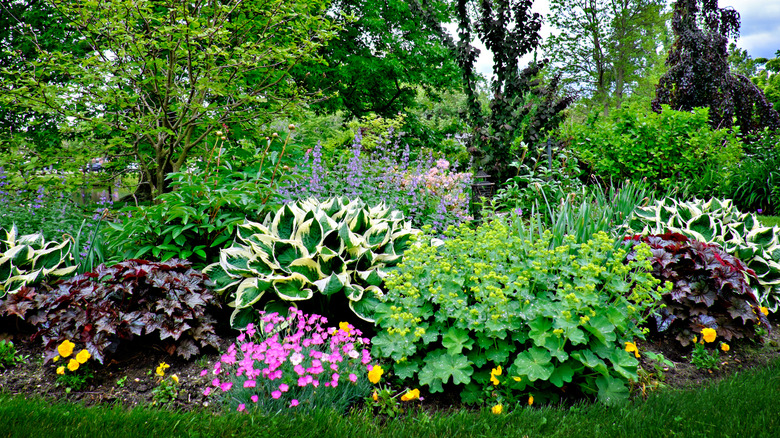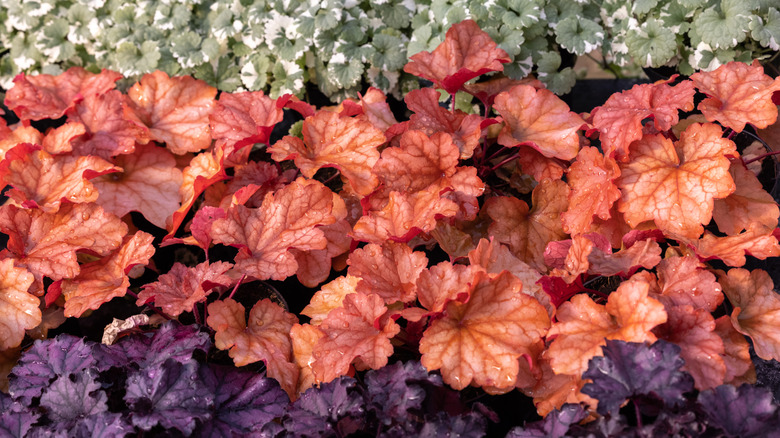The Colorful Ground Cover That Thrives In Morning Sun And Afternoon Shade
Adding a lush ground cover to your flower garden is a great way to keep weeds at bay and complement tall plants. But finding the right fit for an area that receives morning sun and afternoon shade can be tough. Fast-growing species, like thyme, can spread beyond their intended borders, and sun-loving ground covers, like creeping phlox, may grow leggy without proper light. For a tidy edge and a continuous pop of color, with or without blooms, coral bells are a fantastic choice.
Coral bells (Heuchera spp.), also called alumroot, are tender, mounding perennials in the Saxifragaceae family, native to most of North America. Although their common name refers to the small, bell-shaped flowers that top thin stems in late spring and early summer, coral bells are best known for their showstopping foliage. After years of hybridization, this popular landscaping plant can be found in cascading shades of red, green, orange, pink, silver, gold, and even black. Its heart-shaped and deeply lobed leaves may be smooth, fuzzy, or ruffled, adding a unique textural element to shady gardens.
Coral bells' ability to tolerate most climates makes them even more versatile in the home garden. They make great companions to other part-shade-loving plants, such as hostas and astilbe. Plus, coral bells attract beautiful butterflies and hummingbirds to your yard. With the right variety and a few key care tips, your coral bells will continue ringing for years to come.
Caring for your coral bells
Coral bells prefer well-draining, slightly acidic soils with lots of organic material. Clay soils that retain moisture should be amended with compost or gravel, as coral bells will not survive with wet feet for long. Certain cultivars, especially those hybridized with H. villosa, can withstand humid summers, but many prefer the increased circulation that comes with dry air. To prevent powdery mildew, a fungal infection that spreads easily in moist areas, remove any damaged or diseased leaves and cut back on watering until plants dry out.
While most varieties of coral bells thrive in part sun, some cultivars may tolerate sunnier spots, especially in areas with a mild climate year-round. If you notice scalding on the leaves, however, you may want to relocate your coral bells to a shadier patch. Too much shade, and your ground cover may grow leggy. For the ideal location, pick a spot that receives ample morning light but is protected from direct afternoon rays.
Because of their shallow root systems, coral bells need plenty of water to get established, so it's often best to plant in early spring. Deadheading isn't strictly necessary, but it may increase blooms during the summer and early fall. Come winter, you'll want to add a thick layer of mulch around the base of your coral bells to keep the plant anchored in the soil, as the root system may lift as the ground freezes and thaws.
Thanks to creative hybridization, there's a coral bells variety for every garden
With more than 40 striking coral bells varieties (and more hitting nursery shelves each year), these plants can match nearly any garden aesthetic. From green foliage with white flowers to dark burgundy leaves with deep magenta blooms, this colorful ground cover can easily blend into an existing landscape or stand out with its vivid appearance. But these varieties don't just differ in color — by combining specific species of coral bells, breeders have expanded options for hardiness and bloom time.
Many popular varieties are hybrids of the native Heuchera americana, often found in the woodlands of the Midwest, which has a shorter mounding habit of 12 to 15 inches and blooms in late spring. On the other hand, hybrids of the Southeastern native H. villosa can reach 2 feet tall and often bloom much later in the summer through early fall. Most varieties of coral bells remain evergreen through mild winters, but their foliage color may fade slightly during a cold snap. Cultivars may fall within USDA Hardiness Zones 3 through 9, so it's important to check the nursery label to ensure your favorite variety will survive a hard frost in your area.


